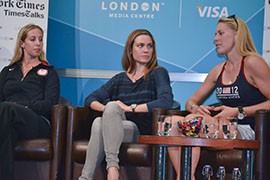Cronkite News has moved to a new home at cronkitenews.azpbs.org. Use this site to search archives from 2011 to May 2015. You can search the new site for current stories.
Women Olympians pay tribute to Title IX
LONDON – U.S. Olympic swimmer Natalie Coughlin now has a deep appreciation for how much Title IX has impacted her life, but, partly because of the law’s effectiveness, that wasn’t always the case.
“I completely took it for granted,” Coughlin said in panel discussion on women athletes. “I remember watching the 1988 games and looking up to Janet Evans and Matt Biondi, and I never thought that women didn’t have the same opportunities in sport. It really wasn’t until I got involved with Women’s Sports Foundation where I started to realize all the opportunities that we’ve had because of things like Title IX.
“Title IX has benefited me tremendously because if it wasn’t for college swimming, I wouldn’t have gotten any of my Olympic medals … If college swimming didn’t exist, I would have never gone beyond high school.”
Title IX, which became law in 1976, mandated equal opportunity for women in sports and has changed the face of sports.
Coughlin won her 12th Olympic medal in London, tying the record previously set by American swimmers Jenny Thompson and Dara Torres for the most career Olympic medals won by a female U.S. athlete.
Coughlin’s fellow panelists, shooter Kim Rhode, gold medal rower Esther Lofgren, two-time gold medalist fencer Mariel Zagunis and basketball player Teresa Edwards, described similar experiences. The women also said a big reason behind their can-do attitudes was the support of their parents and families.
“I didn’t really comprehend the struggles that women were going through because, for me, it wasn’t a matter of you can or you can’t,” Zagunis said. “I was going to do it because I’ve been told I can and no one’s stopping me so far, so I’m going to take this as far as I can go.”
Edwards had a better understanding of the struggles of women athletes by her second Olympics, but the first time around she didn’t give it much thought.
“I was the youngest one on the basketball team in ’84, and I had no idea what I was and what we were doing,” she said. “All I know is no one ever told me I couldn’t be a part of something that big, so I went along and enjoyed the ride.”
The audiences may be smaller for some women’s events, and women typically have slower times than their male counterparts because of physiological differences, but the panelists, each of whom has at least one gold medal, felt those discrepancies didn’t mean they were inferior competitors.
“I’m not afraid to get sweaty or smelly or dirty,” Zagunis said. “You’re just as much of an athlete as everyone else is, you’re going for the same goal.”
Rhode, a five-time medalist who recently tied the world record and won gold in skeet shooting by hitting 99 of 100 clay pigeons, had a unique perspective on competing with men.
“[Shooting is] one of the few sports that we can truly compete on an equal playing field. It doesn’t matter about your size, your strength, your stature,” she said.
When the Olympics first included women in shooting, men and women competed in the same events. That lasted until the 1996 games.
Competing against men was normal for her, Rhode said. She has done so ever since she was a young girl, though growing up there were some men who weren’t used to competing with her.
“There’s been some funny moments,” she said. “When I was a kid, I can remember a gentleman saying that, ‘It’s a lose-lose because she’s 10 years old and she’s a girl. Either way, I’m getting beat by a 10-year-old or by a girl.’”











